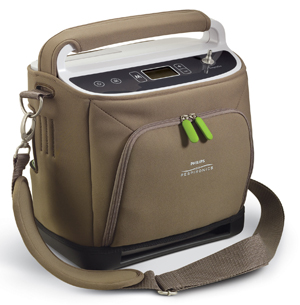Product Premier:
Bridging Both Worlds
Philips Respironics SimplyGo POC serves up pulse dose and continuous flow in a 10-lb. package.
- By David Kopf
- Apr 02, 2012
 The population of patients suffering from chronic obstructive pulmonary disease (COPD) is growing by leaps and bounds, and its members are learning how to live with the oxygen therapy required to treat it. In response to their growing demands for more flexible treatment, Philips Respironics has released SimplyGo, a lightweight portable oxygen concentrator (POC) that offers pulse dose and continuous flow.
The population of patients suffering from chronic obstructive pulmonary disease (COPD) is growing by leaps and bounds, and its members are learning how to live with the oxygen therapy required to treat it. In response to their growing demands for more flexible treatment, Philips Respironics has released SimplyGo, a lightweight portable oxygen concentrator (POC) that offers pulse dose and continuous flow.
COPD is projected to be the third leading cause of death worldwide by 2020 with only heart disease and cerebrovascular disease accounting for more deaths, according to the International COPD Coalition (www.internationalcopd.org). While it can’t be cured, it can be treated with long-term oxygen therapy, such as supplemental home oxygen therapy.
Looking at the U.S. home oxygen use population, there are essentially five types of oxygen patients, according to Tom Williams, MBA, RRT, managing director of home health consulting firm Strategic Dynamics Inc., which provides strategic planning and market analysis services:
- The approximately 15 million undiagnosed COPD patients with unmet needs.
- Oxygen patients that only require oxygen treatment while sleeping. This comprises roughly 38 percent of the known 1.8 million oxygen patients falling under the Medicare benefit.
- Those who need constant oxygen therapy, and have high portability requirements; and
- Those who need constant therapy, but have standard portability requirements. Together with the latter group, these comprise 57 percent of the 1.8 million patients.
- The 5 percent of patients that need constant therapy, but are homebound.
As oxygen providers know, that middle 57 percent of patients clearly want to get out and enjoy and experience life. They do not want to let their COPD hold them back.
“Patients want to be active and do the same things everyone wants to do,” Williams explains, “such as go out to eat, go shopping, go to church, go on trips with their families, etc. while still being on oxygen. They want to be able to take their oxygen and go anywhere, any time and any place they want to.”
Additionally, Williams says, physician prescriptions are driving that increased activity. They want patients to be active, and they work to encourage ambulation because keeping patients active means keeping patients healthy.
“There have been several studies publish that show patients that are active and not sedentary lead a more active and productive life, and live a much longer life,” Williams says.
So, COPD patients want to get out and use their devices. That means their portable oxygen concentrators (POCs) must provide enough oxygen even during exercise; it must be light enough to pull and transport; it must be simple to understand and operate; it must be flexible enough to be used while resting, exercising and doing normal activities; and it must be able to work from AC, DC or battery power.
Traditionally, POCs have provided pulse dose oxygen delivery, which allows devices to be light (under 10 pounds) so that they can be used anywhere, but, because they are pulse dose, they are typically not recommended to use while sleeping, because the patient might not be able to trigger the device, Williams says.
As a response, the SimplyGo “creates a whole new category,” Williams says, but offering both pulse dose and continuous flow, so that it can be used can be used both awake and asleep, delivering 2 LPM with pulse settings 1 through 6, while still weighing in at a manageable 10 pounds. The distinction being that, while there are other POCs that offer both pulse dose and continuous flow, they don’t do it in as light a package, says Frank Lazzaro, director of global product management Philips Respironics.
With the 2 LPM oxygen output, SimplyGo can meet at least 85 percent of the portability needs of nearly all oxygen users including highly active patients or those who require continuous flow, according to Lazzaro.
In addition to weight, the goal was to also make the SimplyGo rugged enough for reliable portable performance, he says. The device was tested to endure extreme vibrations and temperatures, and the shell features a high impact-resistant design. The device also includes a long-life compressor from which Philips expects at least 15,000 hours, Lazzaro says.
The SimplyGo comes with a carrying case, a mobile cart, a rechargeable Lithium Ion battery, DC and AC power cords, an accessory bag, and a user manual. The carrying case will come in several colors and designs to let users have something they feel is more unique to them, and the cart includes oversized wheels to keep it off the ground and away from hazards.
“The SimplyGo was also designed with the provider business in mind,” Lazzaro says. “We are introducing a large variety of flexible warranty and service programs so that the provider can choose which one fits them best — whether they want to lower their acquisition costs and purchase maybe a lesser warranty, or whether they want longer warranties.”
The SimplyGo also is built around a serviceable design that can be serviced much like a stationary concentrator, so that providers can attend to a unit in their own facility.
SimplyGo
Philips Respironics
www.philips.com/simplygo
This article originally appeared in the April 2012 issue of HME Business.
About the Author
David Kopf is the Publisher HME Business, DME Pharmacy and Mobility Management magazines. He was Executive Editor of HME Business and DME Pharmacy from 2008 to 2023. Follow him on LinkedIn at linkedin.com/in/dkopf/ and on Twitter at @postacutenews.